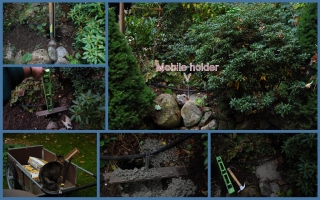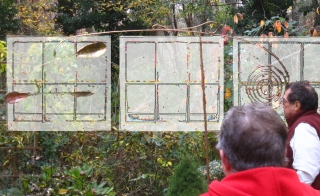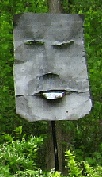Posts Tagged ‘perennials’
Three cheers for the red, white and blue!
The perennial garden is at another peak – this time with summer blooms of hydrangea, evening primrose (), bee balm (monarda), cone flower (Echinacea), lady’s mantle (Alchemilla mollis) and day lilies too various to mention (see this article). Plus continually blooming roses, emerging liatris spicata (Gayfeather) and surprise reappearance of sweet smelling daphne. And, of course, classic annuals. Everything seems early this year.
Spring blooms of Japanese dwarf spirea, clematis, astilbe and peonies have faded. The honeysuckle over the trellis is not very happy this year – thinner and fewer blooms, some blackened. I’m trusting this rugged perennial will recoup next year.
I’m a gardener on vacation – which is a special opportunity to reconnect with dirt, buds and beauty. And weeds. I used my push-pull loop hoe along the driveway bed (80 feet) to clear several years’ of embedded weeds. This is an awesome hoe that makes weeding, if not fun, at least productive.
This year’s hydrangeas look so, so blue. Roses in the Betty Garden spill profusely over the stone wall. Family and friends gathered for our almost annual July 3rd party, celebrating summer and fireworks on Humarock Beach. Scituate police enforced a bonfire ban this year but mobs of people and fireworks attended the traditional fest nevertheless.
Our house is literally abuzz outside with painting preparation. We recently reshingled and re-roofed, the next step will conclude a major exterior renovation long in the works. The carpenter who was prepping the trim discovered (how fitting) carpenter ants on the back wing of the house. Bummer. We’re waiting for the exterminator.
End of vacation – tomorrow we’ll see Cirque du Soleil (“Totem”) perform at Boston Marine Terminal.
Early Spring Dance
New England, March 2012: So odd to have late June’s cameo appearance.
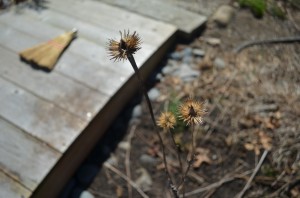
Last year's echinacea
We pensively enjoyed the abundant warmth and sunshine, while summer’s annoyances buzzed and swarmed around us, eventually driving us inside from the patio.
So many things sprang to life this week – the helleboros from Grace & Jerry, which must be thinned and would probably work better at the foot of the stone wall; our accidental hyacinth — a reliable, discarded gift from a beau to one of our teenage daughters, who are both in their 30’s now; streets bursting with magnolias already past their peak on Commonwealth Avenue, Boston; and, allergies galore.
I began clearing last year’s garden refuse and I re-installed the garden foot bridge on reset brick footings that lower the leading edge of the bridge so it’s neatly flush with the adjoining patio. This fundamental satisfaction I will enjoy forever. On walks at Humarock Beach I’m harvesting tumbled, black stones to supplement my medium hard-scape around the bridge; I will place the rounded rocks such that they become a Zen garden-like flow.
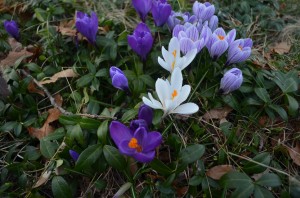
Crocus cast in myrtle
It’s too early to put out my little water feature because here in New England, in March or April, a sudden freeze can descend at any time. One doesn’t put out one’s tomatoes before Mother’s Day. My wish is for a brief cold snap to kill off the flying insects that hatched prematurely, then, a long, drawn out spring with just the right amount of rain. We can have the most spectacular Mays and Junes.
Spring is planning and planting and visioning and acting. Who knows how this season will progress? Is the sudden warmth a friendly lark or a portent of grave weather to come? Neither, both.
Garden Mind
I got the White Flower Farm Spring 2012 catalog this week. It’s a page turner as usual, with saturated floral images of garden gems in perfect flower – where the reds are redder, the greens greener and the true blues truer than life. One day, there might be a garden catalog with wilted, spent flowers going to seed. Unlikely.
My garden overwinters – stark and dreary, especially without frost or snow cover. I hope it gets cold enough to kill the bad bugs; I hope there is enough snow cover, eventually, to supplement the good stuff (my brother told me snow is the poor man’s fertilizer). But, I digress. What is really at work is stillness. No growth, just the remnants of the garden being earth bound — skeletal, essential, and creating reserves for the proper blooming time.
What I have is garden mind.
Our garden (aka, “R” Garden) sits, while last year’s beauty decomposes into next year’s growth. I see the garden’s shape from our upstairs window – the straight and curvy lines, the beds, the flow from one section to another joined by lawn, paths, steps, and bridges. I like this flow and work to refine it in my mind: firm up that edge with a low border, trim that shrub to be a better neighbor, hack that pachysandra, reset those stones, et cetera. In a process of refinement, endless tweaking shapes the garden and morphs its profile. Its essential personality, established long ago, matures incrementally, bringing charm, whimsy and nature into harmony improved by age.
Of course it’s a living thing and changes occur, apparently spontaneously, as well. Like the clumping bamboo that finally, finally decided to become the screen I imagined ten years ago. Who knew it would take this long? I suppose that’s where annuals come in. They provide the instant gratification that delights the eye and other senses. Not much mystery but adornment galore and great expectations easily met. We enjoy the splash, the visual spice, and the abundance of blooms overlaying the perennial foundation.
The garden mind dwells on ideas and suffers no toil. No: weeding, spraying, mowing, aching backs or biting no-see-ums. It sees golden possibilities; it harbors hopes and plans — flights of fancy that could occupy the whole of next season. It’s a great place to visit.
Daylilies For Sale
Marshfield is at its best in the summer. The Farmers Market runs every Friday (2-6pm). The beaches beckon. We dine al fresco. My garden flourishes and the yard becomes a leisurely extension of daily living. Other local resources make summer special, too. I recently discovered a new (to me) nearby marvel — Dick & Carolyn Houseman’s Daylilies For Sale on Union Street, Marshfield.
I know the Housemans from our bookclub. When Dick speaks, we listen. I had heard about their daylily event and Carolyn invited me to visit this year at the peak of their season. Post heat-of-the-day last Saturday, I dropped by and beheld the lilies of their fields. Wow.
no images were found
Carolyn gave me the overview: They started about 9 years ago on a partial whim, heading toward retirement.
Now both are retired and working tirelessly full time to tend the field that they started small and have grown to include over 250 daylily cultivars.Names like: Chicago Ruby, Cisty, Kindly Light, Maurice Rivero, Kwanso, Web of Intrigue, Siloam Red Ruby, Chicago Sun, Lemon Dazzler, Cedar, Monrovia Gem, Chicago (it goes on…). What’s with the preponderance of lilies named “Chicago?”
[Not a valid template]
They also have grown their mailing list to over 150 devoted followers. Loyal customers even bring plants to them – sometimes for identification, sometimes for donation. It suits them just fine and Carolyn marvels at friendly gardeners who stop by to exchange daylily tales. Gardeners are the nicest people, she says.
July is winding down. According to their schedule next weekend is the 2011 finale, until next year. Give ’em a shout, drop by, get on their mailing list (abijahfarm @ yahoo.com). Tell them a nice person sent you.
Herbs – the spice of life
When late afternoon arrives in our patch of yard, we turn on the reading lights. That’s because we live in dappled shade and shadows from our forested northeastern exposure. 1/2 block away it’s full sun, while we’re calling it a day.
One outcome of our scant daylight is we don’t grow food, or anything else that requires full sun. Which is OK by me because my short stint as a food grower was neither a personal or agricultural success.
Consumers are people, too
I support the concept of growing your own nutrition, but I do not support the worry: fungus, beetles, blight, cut worms, watering, fertilizing, weeding, thinning, fencing and harvesting gallons of one thing (I hope you like squash, dear). And then, it starts again next year. From scratch.
Do I lack intestinal fortitude? No, I just can’t tolerate the suspense of bringing in a crop. I gladly shop for local produce. Just leave me to my perennials.
Best of both worlds
I designed my garden for other senses – mind, eye, nose
– outdoor spaces, fragrant offerings, inspiring creations, intriguing curves, mini-vistas and low maintenance. OK, I pamper the roses a bit. Everything else weathers; a planting survives and thrives or … succumbs. Perennial pragmatism.My one exception: herbs and annuals in pots. I hate buying fresh mint at the supermarket. Ditto parsley, sage rosemary and thyme, invariably expensive or trucked from Mexico. In pots, these herbs unfailingly just grow, and without fuss — my kind of crop! They satisfy my gardening principles while providing a culinary and aesthetic je ne sais quoi.
Besides the flavor-your-food value of herbs, groupings of pots in different shapes and sizes partition and highlight an area, add graceful greenery / vivid accents, and blend practical herbs with vibrant annuals (my fave – nasturtium with lobelia). Pots of varying sizes, habitats and materials punctuate my external rooms.
I have a few herbal and non-herbal relics that winter over — bits of this and that: liatris spicata, lamium “White Nancy”, dicentra, ferns. Even my potted oregano returns each year and mint, running freely in the perennial beds, is rampant. While they do not survive Zone 6A winter, I’ve harvested parsley in late December and rosemary in January. First frost does in the basil – it’s known as a tender perennial.
Terracotta and Not
I use both clay pots and plastic pots. Classic terracotta (literally baked earth, unglazed clay) is porous, warm and weathered. Saucers under the clay pots extend the watering effect. Plastic scores lower for aesthetics but meets the low maintenance requirement because it conserves moisture much better than terracotta. That means less stress on the plants and less work for me.
I’ve taken to the heavily glazed, gigantic earthenware pots from Vietnam. They conserve water, do not crack like terracotta and make a bold statement that anchors a grouping of smaller pots. Filled with soil, they stay put!
Global watering
For pots that need chronic watering, I discovered a remedy that works pretty well — the glass watering globes that you fill with water and stick into the potted soil.
In the past I had tried mixing in the gelatinous granules (polymers) that soak up water and then release it to the plants. It’s a clever idea that doesn’t work well. Mostly the granules expand beyond reason, force the soil out of the pot, and don’t deliver much water to the roots of your potted plants. My experience is supported by research.Food for Thought
While my aesthetic vision continues to conjure up garden designs, I find joy in snipping fresh rosemary, basil, and perennial mint into my cuisine, or pinching a spicy nasturtium flower to decorate dinner. It’s another way I delight my soul.
Seeds are in
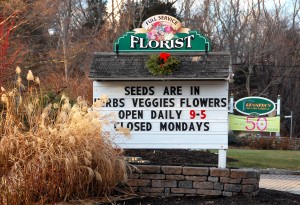
January 8, 2011 - Seeds are in
Like plants, gardeners come in many varieties, but they seem to share some common traits: imagination, faith, patience, optimism, diligence, hope…
What other gardener traits can you think of? Share your perspective.
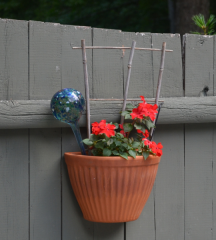
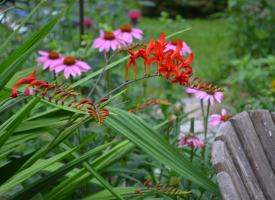
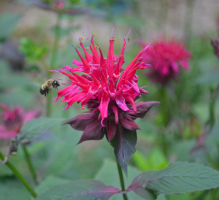
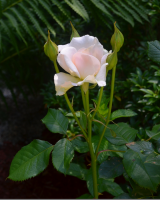
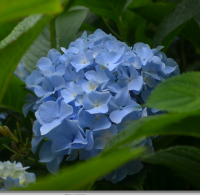
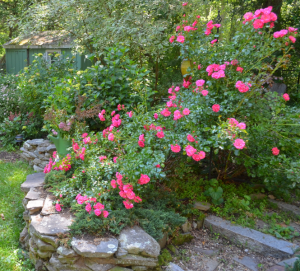
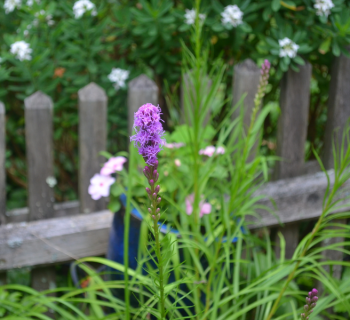
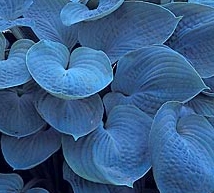
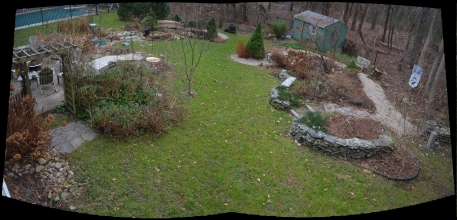


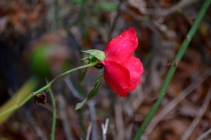





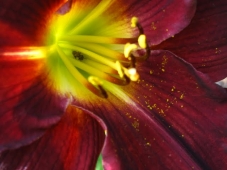


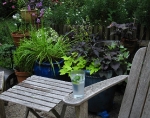 pots-with-chair
pots-with-chair potted-herbs-annuals
potted-herbs-annuals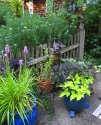 pots-with-chair2
pots-with-chair2 pots-sweetpotato
pots-sweetpotato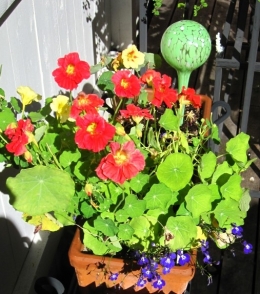

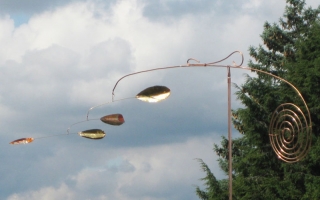
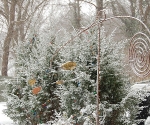 sarabande-in-snow-4
sarabande-in-snow-4 sarabande-in-snow-5
sarabande-in-snow-5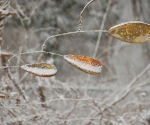 Sarabande In Snow 2
Sarabande In Snow 2